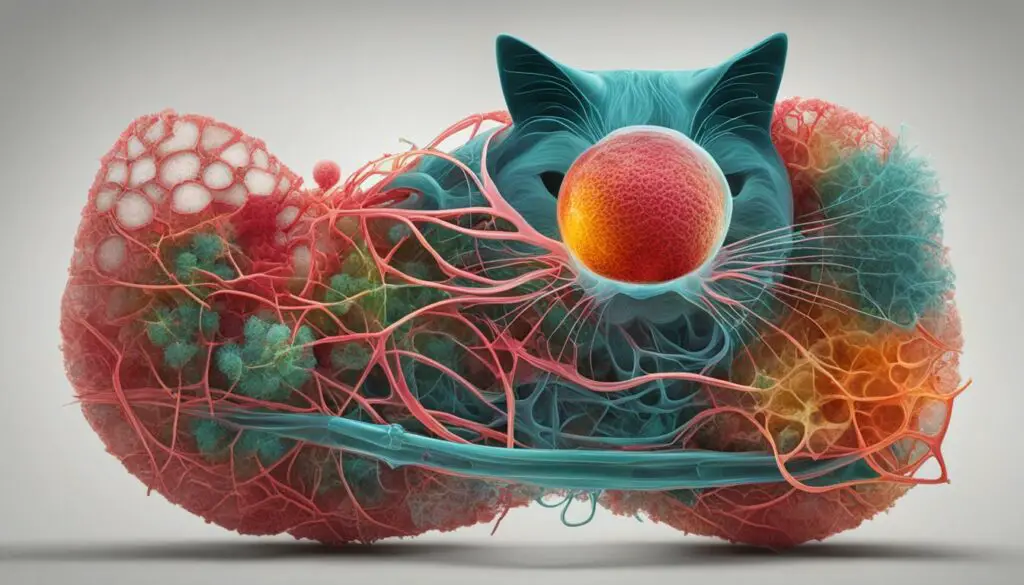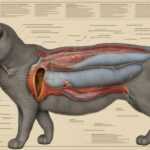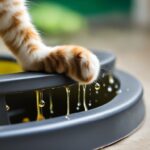Do you find your cat peeing on himself and wonder why? It can be a concerning issue, but understanding the causes and finding solutions can help resolve this problem. Incontinence, spraying, marking – these behaviors can be indicators of underlying issues involving the bladder and urinary tract. As a cat owner, it’s essential to be aware of the potential medical reasons behind your cat’s urination problems and seek the guidance of a veterinarian for proper diagnosis and treatment.
Urinary incontinence, whether congenital or acquired, refers to the involuntary leakage of urine in cats. This condition can result from problems with storing urine or urinating. Symptoms of urinary incontinence include your cat not squatting to urinate, finding urine in their bed or near the urethral opening, and the cat being unaware of their urination. Understanding the causes and seeking appropriate treatment can help your cat find relief and regain control over their urinary habits.
Diagnosing the underlying cause of your cat’s urinary incontinence may involve physical examinations, urinalysis, and imaging tests. Once the cause is identified, treatment options can range from medications to surgical repair, depending on the specific condition your cat is experiencing. It’s important to work closely with your veterinarian to determine the best course of action for your cat’s well-being and comfort.
Key Takeaways:
- Urinary incontinence in cats can be caused by congenital or acquired factors
- Symptoms of urinary incontinence include not squatting to urinate and finding urine in inappropriate places
- Proper diagnosis and treatment are crucial for addressing urinary incontinence in cats
- Preventive measures, such as weight management and maintaining good litter box hygiene, can help minimize the risk of urinary incontinence
- Regular veterinary check-ups are important for managing urinary incontinence and overall feline health
Symptoms of Urinary Incontinence in Cats
Urinary incontinence in cats presents with several noticeable symptoms that can help pet owners identify the issue. It’s essential to differentiate between urinary incontinence and inappropriate urination, as they require different approaches for management and treatment. By understanding the symptoms of urinary incontinence, cat owners can seek appropriate veterinary care and support their feline companions effectively.
The symptoms of urinary incontinence in cats include:
- Not squatting or being in the position to urinate
- The cat being unaware of urination
- Urine found in bed or near the urethral opening
- Staining or smell near the urethral opening
These symptoms indicate that the cat is experiencing involuntary urine leakage, which can be distressing for both the cat and the owner. It’s crucial to observe these symptoms and consult with a veterinarian for a proper diagnosis.
“Inappropriate urination in cats can be a voluntary action, while urinary incontinence is characterized by involuntary urine leakage.”
It’s important to note that inappropriate urination can also exhibit additional symptoms, such as posturing to urinate, straining or pain during urination, reoccurring urination in certain areas, and urination on vertical surfaces. These symptoms can help differentiate between urinary incontinence and other urinary issues or behavioral problems.
| Symptom | Description |
|---|---|
| Not squatting or being in the position to urinate | The cat does not assume the typical crouched position when attempting to urinate. |
| The cat being unaware of urination | The cat does not show any signs of awareness or discomfort while urinating. |
| Urine found in bed or near the urethral opening | Urine is discovered in areas where the cat rests or near the opening of the urethra. |
| Staining or smell near the urethral opening | There may be visible staining or a distinct smell near the opening of the urethra. |
If any of these symptoms are observed in a cat, it is recommended to consult with a veterinarian for a thorough evaluation and appropriate management.
Causes of Urinary Incontinence in Cats
Urinary incontinence in cats can have various causes, both congenital and acquired. Congenital factors include ectopic ureter, where the ureter is attached in the wrong location, and urethral sphincter abnormalities. These conditions can affect the cat’s ability to control urination, leading to involuntary leakage. Acquired causes of urinary incontinence can include spinal abnormalities, such as injury to the spine or vertebrae, which can affect the nerves responsible for bladder and sphincter control. Additionally, conditions like urethral blockage and a decrease in nerves to the bladder wall or urethral sphincter can also contribute to urinary incontinence.
In some cases, urinary incontinence in cats may be caused by feline leukemia virus, although further research is needed to fully understand this relationship. It is important to note that feline urinary incontinence can have multiple causes, and a thorough evaluation by a veterinarian is necessary to determine the underlying factor in each individual case.
To summarize, the causes of urinary incontinence in cats can be categorized as congenital or acquired. Congenital factors include ectopic ureter and urethral sphincter abnormalities, while acquired causes can range from spinal abnormalities to urethral blockage. Understanding the underlying cause is crucial in developing an appropriate treatment plan for cats suffering from urinary incontinence.
Causes of Urinary Incontinence in Cats
| Cause | Description |
|---|---|
| Congenital Factors | – Ectopic ureter: Ureter attached in the wrong location – Urethral sphincter abnormalities |
| Acquired Factors | – Spinal abnormalities: Injury or vertebral abnormalities affecting bladder and sphincter nerves – Urethral blockage – Decrease in nerves to the bladder wall or urethral sphincter |
| Feline Leukemia Virus | – Suspected cause, further research required |
Mimics of Urinary Incontinence
When it comes to urinary incontinence in cats, there are several metabolic diseases that can mimic the symptoms. These conditions, such as diabetes, liver disease, hyperthyroidism, and renal disease, can increase the amount of urine produced and result in increased accidents. It’s important for veterinarians to accurately diagnose urinary incontinence and rule out these mimicking conditions through thorough clinical history, physical exams, and diagnostic tests.
To differentiate between urinary incontinence and these metabolic diseases, veterinarians may perform urinalysis to check for infections or crystals, blood tests to identify underlying causes, and imaging tests like radiographs or ultrasound to examine the anatomy of the bladder and urethra. These diagnostic tools help veterinarians determine the presence of urinary incontinence and differentiate it from other conditions that may mimic its symptoms.
By properly diagnosing urinary incontinence and ruling out any mimicking conditions, veterinarians can provide targeted treatment and management strategies for cats. This ensures that the underlying cause of urinary incontinence is addressed, leading to more effective treatment and improved quality of life for affected cats.
“Urinary incontinence in cats can be challenging to diagnose as there are several diseases that can mimic its symptoms,” says Dr. Smith, a veterinarian specializing in feline medicine.
“Understanding these mimics is crucial for accurate diagnosis and effective treatment. By ruling out metabolic diseases like diabetes, liver disease, hyperthyroidism, and renal disease, we can focus on the correct underlying cause of urinary incontinence and provide appropriate care.”
| Metabolic Disease | Symptoms |
|---|---|
| Diabetes | Increased thirst, frequent urination, weight loss |
| Liver Disease | Jaundice, decreased appetite, vomiting |
| Hyperthyroidism | Weight loss, increased appetite, hyperactivity |
| Renal Disease | Increased thirst, decreased appetite, weight loss |
Dr. Smith emphasizes the importance of thorough diagnostic workup when dealing with urinary incontinence in cats. “We need to consider and rule out all possible causes, including these mimicking conditions, to develop the most effective treatment plan. This ensures that we provide the best care for our feline patients and improve their quality of life.”

How Veterinarians Diagnose Urinary Incontinence in Cats
Diagnosing urinary incontinence in cats requires a comprehensive approach that combines physical exams and diagnostic tests. Veterinarians use various tools and techniques to identify the underlying cause of the condition and differentiate it from inappropriate urination.
One of the primary diagnostic methods is urinalysis, which involves analyzing a sample of the cat’s urine. This helps identify any signs of infection, crystals, or other abnormalities that may be contributing to the urinary incontinence. Blood tests are also commonly used to assess the overall health of the cat and check for any underlying medical conditions that could be causing the problem.
In addition to these tests, veterinarians may also use imaging techniques such as radiographs or ultrasound to get a closer look at the bladder and urethra. These imaging tests help identify any structural abnormalities or blockages that may be affecting the cat’s urinary function. By combining the information gathered from these diagnostic tools, veterinarians can make a more accurate diagnosis and determine the most appropriate treatment plan.
Overall, the diagnostic process for urinary incontinence in cats is complex and may require multiple tests and examinations. It is essential for cat owners to work closely with their veterinarians to provide detailed information about their cat’s symptoms and medical history. This collaboration allows veterinarians to make an accurate diagnosis and develop an effective treatment plan tailored to the individual cat’s needs.
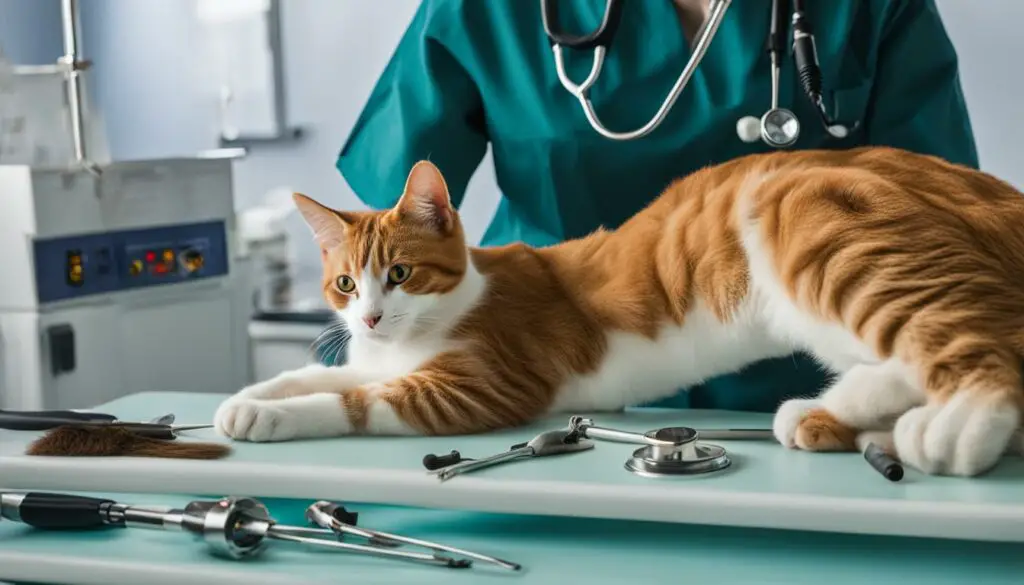
Note: The image above shows a veterinarian examining a cat as part of the diagnostic process for urinary incontinence in cats.
Treatment of Urinary Incontinence in Cats
When it comes to treating urinary incontinence in cats, the approach will depend on the underlying cause. The goal is to address the root issue and alleviate symptoms to improve the cat’s overall quality of life. Treatment options for urinary incontinence may include medications, supportive care, symptomatic treatment, antibiotics, prazosin, or surgical repair.
Medications play a crucial role in managing urinary incontinence. Antibiotics may be prescribed to treat any underlying infections that may contribute to the condition. Additionally, medications that aid in bladder emptying or address urethral swelling or blockage may be prescribed to improve urinary control.
In some cases, supportive care and symptomatic treatment may be necessary. This can involve creating a calm and stress-free environment for the cat, providing easy access to litter boxes, and using pheromones or vitamin supplements to decrease stress.
If the underlying cause of urinary incontinence is structural, such as bladder stones or urethral abnormalities, surgical repair may be recommended. Procedures such as removing bladder stones, placing a temporary urethral catheter, or performing periurethral surgery in male cats can help restore normal urinary function.
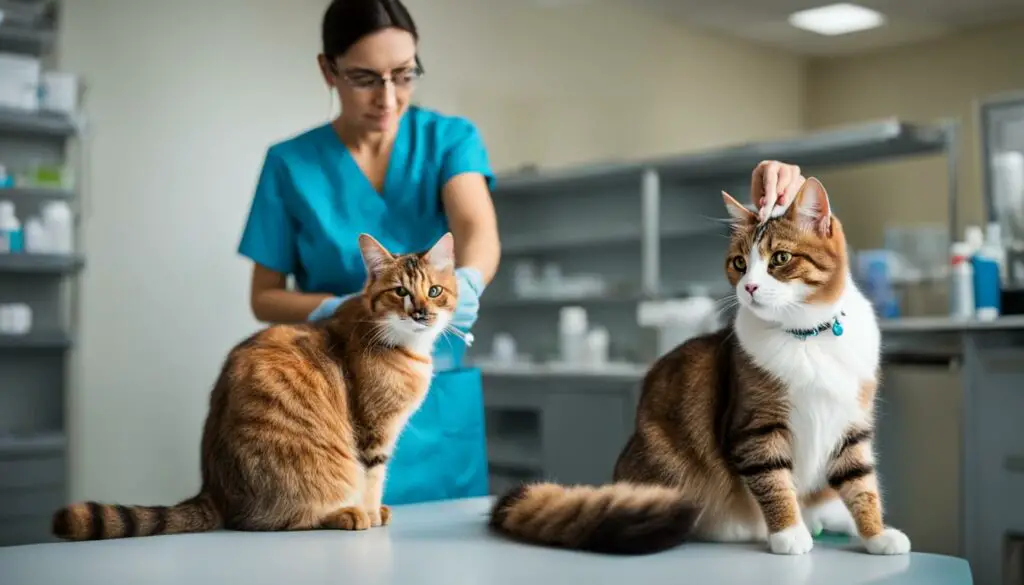
Treatment Options for Urinary Incontinence in Cats
| Treatment | Description |
|---|---|
| Medications | Prescribed to treat infections and aid bladder emptying |
| Supportive Care | Create a calm environment and provide easy access to litter boxes |
| Symptomatic Treatment | Use pheromones or vitamin supplements to decrease stress |
| Antibiotics | Treat underlying infections contributing to urinary incontinence |
| Prazosin | Prescribed to address urethral swelling or blockage |
| Surgical Repair | Procedures to address structural abnormalities in the bladder or urethra |
It’s important to work closely with a veterinarian to determine the most appropriate treatment plan for your cat. They will consider the cat’s individual needs, medical history, and the underlying cause of urinary incontinence to develop a tailored approach that maximizes the chances of successful management and improvement of symptoms.
Recovery and Management of Urinary Incontinence in Cats
Once the underlying cause of urinary incontinence in cats has been identified and appropriate treatment has been initiated, the focus shifts to the recovery and management phase. Recovery time can vary depending on the individual cat and the severity of the condition. Close adherence to the veterinarian’s instructions and careful monitoring of the cat’s symptoms are crucial for a successful recovery.
During the recovery period, it is important to create a supportive environment for the cat. This may involve making changes to the cat’s diet to prevent urinary crystals or stones and increase water intake. Feeding wet food can be beneficial in increasing fluid consumption. Additionally, providing a comfortable and easily accessible litter box is important to encourage proper elimination habits.
In some cases, additional supportive measures may be recommended. These can include alternative therapies such as acupuncture or the use of hyperbaric chambers to promote healing and reduce inflammation. Creating a stress-free environment by using pheromone sprays or diffusers and providing adequate mental stimulation can also be beneficial.
| Treatment | Description |
|---|---|
| Dietary changes | Modifying the cat’s diet to prevent urinary crystals or stones and increase water intake. |
| Litter box management | Ensuring the litter box is easily accessible and clean to encourage proper elimination habits. |
| Alternative therapies | Utilizing acupuncture or hyperbaric chambers to promote healing and reduce inflammation. |
| Stress reduction | Creating a stress-free environment using pheromone sprays or diffusers and providing mental stimulation. |
Regular monitoring of the cat’s progress and follow-up visits with the veterinarian are essential to evaluate the effectiveness of the treatment plan and make any necessary adjustments. Ongoing management may be required for some cats, as complete resolution of urinary incontinence may not always be possible. By working closely with the veterinarian and implementing appropriate measures, cats with urinary incontinence can lead comfortable and happy lives.
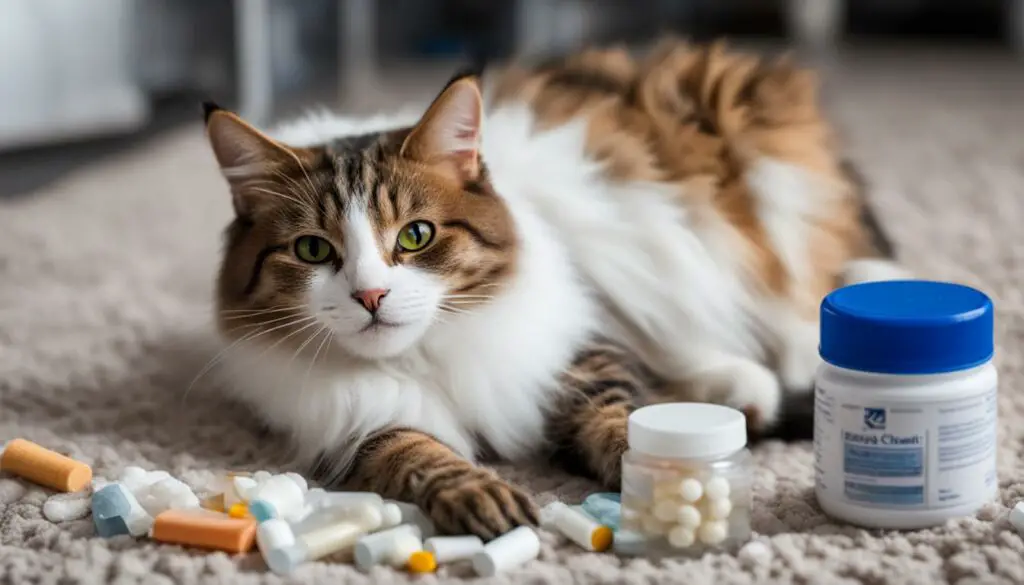
Prevention of Urinary Incontinence in Cats
Preventing urinary incontinence in cats is an important aspect of maintaining their overall health and well-being. By implementing a few preventive measures, cat owners can minimize the risk of urinary issues and ensure their furry companions lead comfortable lives.
Weight Management
One of the key factors in preventing urinary incontinence is maintaining a healthy weight for your cat. Obesity can increase the risk of urinary tract problems and put unnecessary strain on the bladder and urinary system. By providing a balanced diet and monitoring your cat’s food intake, you can help prevent weight-related urinary issues. Consult with your veterinarian to determine the appropriate diet and feeding schedule for your cat to maintain a healthy weight.
High-Quality Food
The quality of food that your cat consumes can also impact their urinary health. Feeding your cat a high-quality diet, especially one that includes wet food, can help prevent urinary crystals and stones from forming. Wet food has a higher moisture content, which helps to keep the urinary system well-hydrated and reduce the risk of blockages. Consult with your veterinarian to choose a nutritionally balanced diet that meets your cat’s specific needs.
Litter Box Hygiene
Proper litter box hygiene is essential in preventing urinary issues in cats. A clean and well-maintained litter box encourages regular urination and can help identify any changes in your cat’s urinary habits. Scoop the litter box daily to remove waste and ensure that there are enough litter boxes available for multiple cats. Additionally, provide a litter box that suits your cat’s preferences, including the type of litter and the size of the box. Regularly monitoring and maintaining the litter box can help prevent stress-related urinary issues.
| Preventive Measures | Benefits |
|---|---|
| Weight Management | Reduces the risk of urinary tract problems |
| High-Quality Food | Prevents the formation of urinary crystals and stones |
| Litter Box Hygiene | Encourages regular urination and reduces stress |
By implementing these preventive measures and working closely with your veterinarian, you can minimize the risk of urinary incontinence in your cat and provide them with a healthy and happy life.
Anxiety and Stress as Possible Causes
Anxiety and stress can have a significant impact on a cat’s urinary health, potentially leading to urinary incontinence. When cats experience stress or anxiety, it can affect their bladder and urinary tract function, resulting in involuntary urine leakage. These emotional states can trigger the release of certain hormones that disrupt bladder control and contribute to urinary incontinence. Stressful situations, changes in the environment, and other behavioral factors can all play a role in the development of urinary incontinence in cats.
Creating a supportive and calming environment for your cat is crucial in alleviating their symptoms. Providing a safe space with minimal disruptions, comfortable hiding spots, and engaging toys can help reduce anxiety and stress levels. It’s also important to establish a consistent routine and avoid sudden changes that may trigger stress. If you suspect anxiety or stress as the underlying cause of your cat’s urinary incontinence, consulting with a veterinarian or a feline behaviorist can help you develop a comprehensive approach to manage their condition.
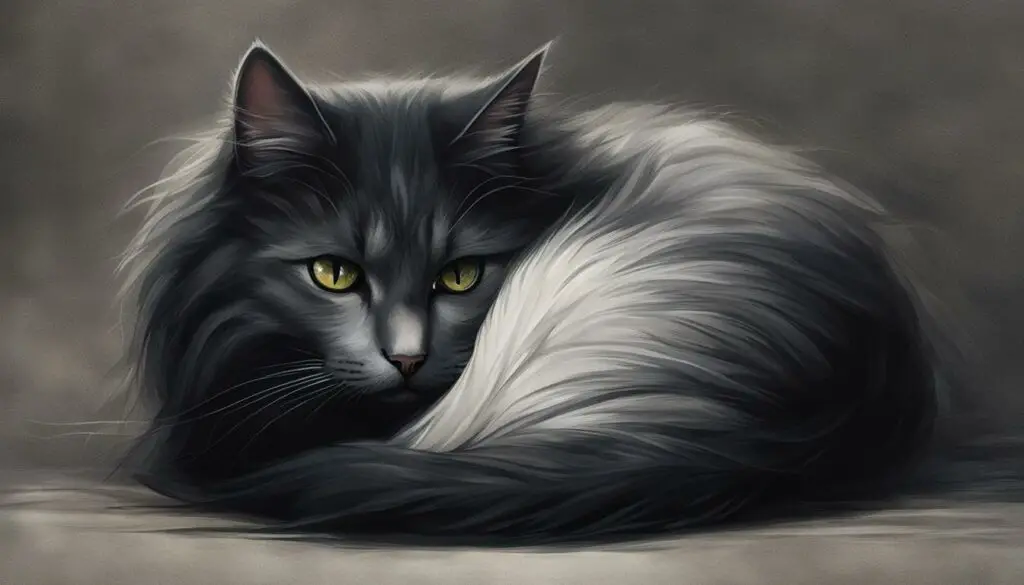
Managing Anxiety and Reducing Stress Levels
- Provide a quiet and peaceful environment for your cat, away from loud noises or disturbances.
- Offer hiding spots and vertical spaces to create a sense of security.
- Use pheromone diffusers or sprays that mimic natural calming scents to help reduce anxiety.
- Implement a consistent routine and avoid sudden changes in your cat’s environment.
- Engage your cat in playtime and provide interactive toys to keep them mentally stimulated.
- Consider consulting with a veterinarian or feline behaviorist for additional guidance and support.
“Creating a supportive and calming environment for your cat is crucial in alleviating their symptoms.”
Stress Management Techniques for Cats
| Technique | Description |
|---|---|
| Aromatherapy | Using essential oils or herbal extracts known for their calming effects, such as lavender or valerian. |
| Acupuncture | The insertion of fine needles into specific points on the body to promote relaxation and relieve stress. |
| Massage | Gentle massaging techniques applied to your cat’s muscles to help them relax and reduce tension. |
| Music Therapy | Playing soothing music or nature sounds to create a calming atmosphere for your cat. |
By addressing anxiety and stress as possible causes of urinary incontinence, you can help improve your cat’s overall well-being and manage their condition effectively. Remember, patience, consistency, and creating a stress-free environment are key to supporting your cat through their journey to better urinary health.
The Importance of Positive Reinforcement in Training
When it comes to addressing urinary incontinence in cats, positive reinforcement training techniques can be incredibly valuable. Unlike punishment or negative reinforcement, which can increase stress and worsen the issue, positive reinforcement focuses on rewarding desired behaviors. By using this approach, we can promote the development of good litter box habits and encourage cats to use the appropriate area for urination.
Positive reinforcement involves providing treats, praise, or playtime when the cat uses the litter box correctly. This helps reinforce the desired behavior and can assist in managing urinary incontinence. By creating positive associations with using the litter box, cats are more likely to repeat the behavior and reduce accidents.
Training sessions should be consistent and conducted in a calm, stress-free environment. By using positive reinforcement, cat owners can help their furry friends develop appropriate litter box habits and minimize urinary incontinence issues. It’s important to remember that patience is key, as it may take time for cats to fully adapt to the training techniques.
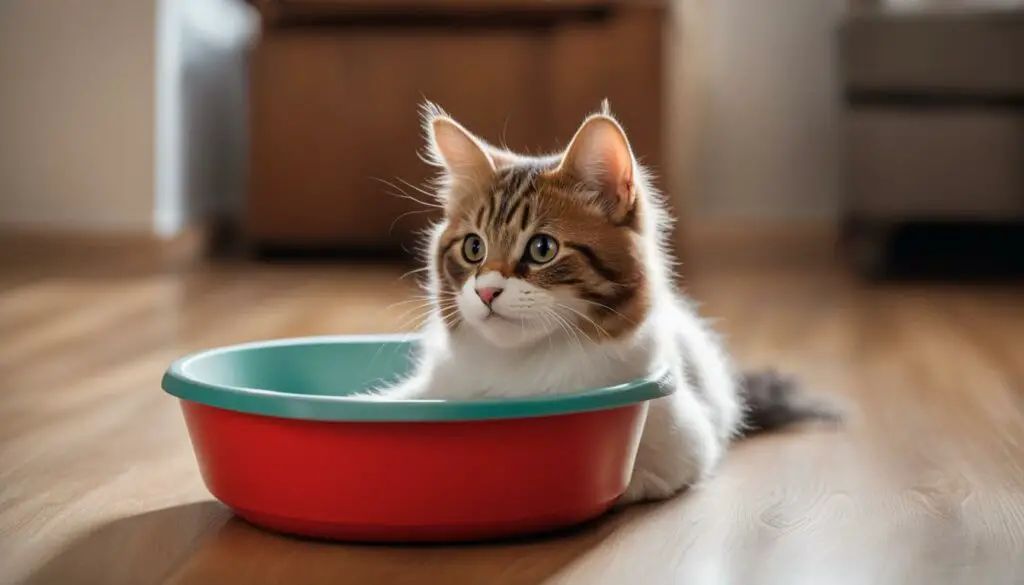
| Benefits of Positive Reinforcement | Why It Works |
|---|---|
| Creates a positive association with using the litter box | By rewarding desired behavior, cats learn that using the litter box leads to positive experiences. |
| Reduces stress and anxiety | Positive reinforcement helps create a calm and supportive environment, minimizing stress-related urinary incontinence. |
| Strengthens the bond between cat and owner | Positive training sessions provide opportunities for bonding and trust-building, enhancing the relationship. |
| Encourages consistent litter box habits | With positive reinforcement, cats are more likely to develop and maintain appropriate litter box habits. |
Importance of Litter Box Setup and Management
When it comes to managing urinary incontinence in cats, the proper setup and management of the litter box play a crucial role. Creating a conducive environment for your cat’s toileting needs can help minimize accidents and promote better urinary control. Here are some key factors to consider:
Litter Box Location:
The location of the litter box is essential for a cat with urinary incontinence. Choose a quiet, low-traffic area that provides easy access for your cat. Avoid placing the litter box near loud noises or disturbances that may cause stress or anxiety.
Litter Box Cleanliness:
Maintaining a clean litter box is vital for cats with urinary incontinence. Regularly scoop the litter and replace it as needed to prevent odors and the buildup of bacteria. Clean the litter box with mild, unscented soap and water, avoiding harsh chemicals that may irritate your cat’s sensitive urinary system.
Litter Box Size and Preferences:
Ensure that the litter box is appropriately sized for your cat. It should be large enough for your cat to comfortably turn around and dig. Experiment with different types of litter to find the one your cat prefers. Some cats may have texture or odor preferences, so providing choices can encourage proper litter box usage.
By paying attention to the location, cleanliness, size, and preferences of the litter box, you can create an environment that promotes proper urinary control and minimizes accidents for your cat with urinary incontinence.
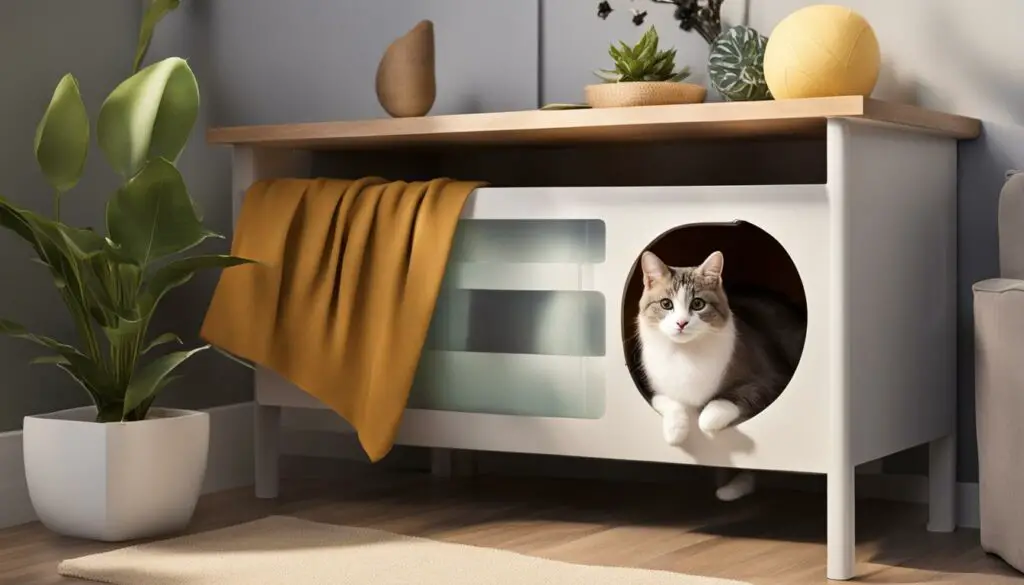
Table: Tips for Litter Box Setup and Management
| Aspect | Tips |
|---|---|
| Location | Choose a quiet, low-traffic area away from stressors. |
| Cleanliness | Scoop the litter daily and replace it regularly. |
| Size | Provide a litter box that is spacious enough for your cat to move comfortably. |
| Preferences | Offer different types of litter to find the one your cat prefers. |
Importance of Cleanliness and Odor Control
When it comes to managing urinary incontinence in cats, cleanliness and odor control play a crucial role in ensuring their comfort and hygiene. By maintaining a clean environment and effectively managing odors, we can help minimize discomfort and prevent potential complications.
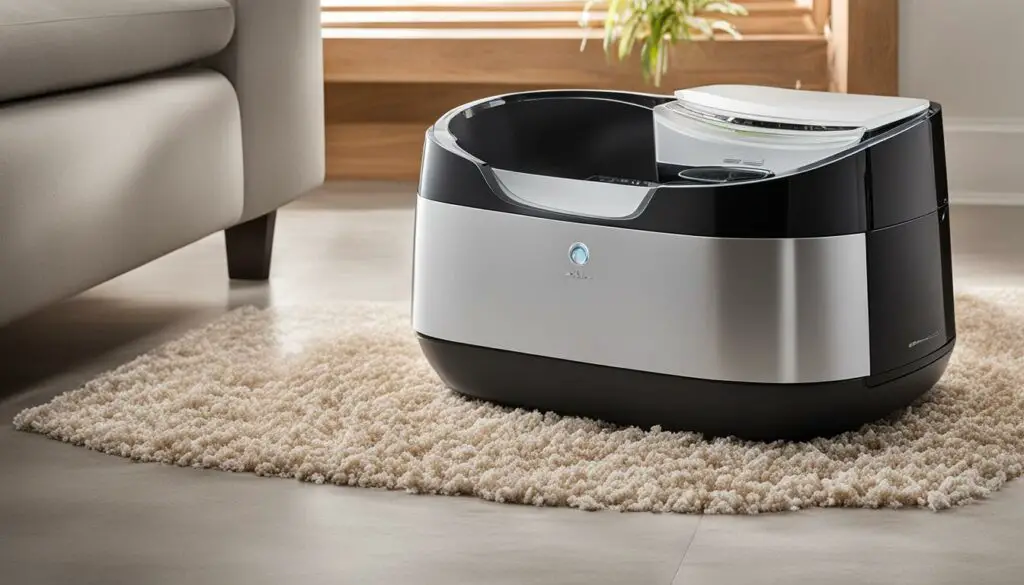
Regular cleaning of the litter box is essential in reducing unpleasant odors and preventing bacterial growth. Promptly removing any soiled litter and using appropriate cleaning products can help minimize lingering smells and maintain a hygienic environment for your cat. It’s important to not only clean the litter box itself but also any affected areas outside the litter box, such as furniture or bedding, to prevent odors from spreading.
In addition to cleanliness, selecting the right litter and litter box products can also contribute to odor control. There are various options available, such as odor-absorbing litter and litter box deodorizers, which can help neutralize smells and provide a fresh environment for your cat.
By prioritizing cleanliness and effective odor control, we can create a comfortable and hygienic space for our cats with urinary incontinence, promoting their overall well-being and minimizing the impact of this condition on their daily lives.
Importance of Litter Box Training and Reinforcement
When it comes to managing urinary incontinence in cats, litter box training and reinforcement play a crucial role. By implementing consistent and positive training methods, cat owners can help their furry companions develop good litter box habits and reduce instances of accidents. It’s important to remember that cats are intelligent animals and respond well to positive behavior reinforcement.
Consistency is key when it comes to litter box training. Providing a clean litter box in a quiet and accessible location is essential. Cats have their preferences when it comes to litter types and box sizes, so it’s important to find the right combination that suits your cat’s needs. Additionally, cats appreciate privacy, so placing the litter box in a secluded area can help them feel more comfortable and encourage regular use.
Positive reinforcement involves rewarding desired behaviors. Whenever your cat uses the litter box correctly, praise them and offer a small treat or extra attention. This positive association will help reinforce the idea that the litter box is the appropriate place for urination. If accidents occur, avoid scolding or punishing your cat, as this can increase stress and worsen the issue. Instead, redirect them to the litter box and provide encouragement.
Working closely with a veterinarian or animal behaviorist can provide valuable guidance and support in designing an effective litter box training plan. They can assess your cat’s unique needs, address any underlying medical issues, and provide further recommendations. With patience, consistency, and positive reinforcement, you can help your cat develop good litter box habits and manage their urinary incontinence effectively.
| Litter Box Training Tips |
|---|
| Ensure the litter box is clean and accessible. |
| Experiment with different litter types and box sizes to find your cat’s preference. |
| Place the litter box in a quiet and private location. |
| Provide positive reinforcement, such as treats and praise, when your cat uses the litter box correctly. |
| Avoid punishment or scolding and redirect your cat to the litter box if accidents occur. |
Importance of Regular Veterinary Check-ups
Regular veterinary check-ups are vital for the overall health and well-being of your cat, especially when it comes to managing urinary incontinence. These check-ups allow veterinarians to monitor your cat’s condition and detect any underlying issues or changes in urinary function. By scheduling regular visits, you can ensure that your cat receives timely preventive care and appropriate health monitoring.
During a veterinary check-up, your veterinarian will perform a thorough physical examination, including assessing the size and thickness of the bladder. They may also recommend additional diagnostic tests, such as urinalysis, blood tests, and imaging, to gain a comprehensive understanding of your cat’s urinary health. These tests can help differentiate between urinary incontinence and other potential causes of inappropriate urination, such as urinary tract infections or metabolic diseases.
Preventive care measures, such as vaccinations and parasite control, are also an essential part of regular veterinary check-ups. These measures can help maintain optimal health and potentially prevent urinary issues. Furthermore, discussing any concerns or changes in your cat’s urinary habits during these visits allows your veterinarian to provide appropriate guidance and treatment recommendations to manage urinary incontinence effectively.
| Benefits of Regular Veterinary Check-ups for Cats with Urinary Incontinence |
|---|
| Early detection of underlying conditions or changes in urinary function |
| Timely preventive care measures to maintain optimal health |
| Comprehensive diagnostic tests to differentiate urinary incontinence from other causes of inappropriate urination |
| Appropriate guidance and treatment recommendations to manage urinary incontinence effectively |
| Opportunity to discuss any concerns or changes in urinary habits |
By attending regular veterinary check-ups, you can work collaboratively with your veterinarian to ensure the best possible care for your cat with urinary incontinence. These visits provide a valuable opportunity for you to address any questions or concerns you may have, create an individualized treatment plan, and receive ongoing support to help your cat lead a comfortable and healthy life.
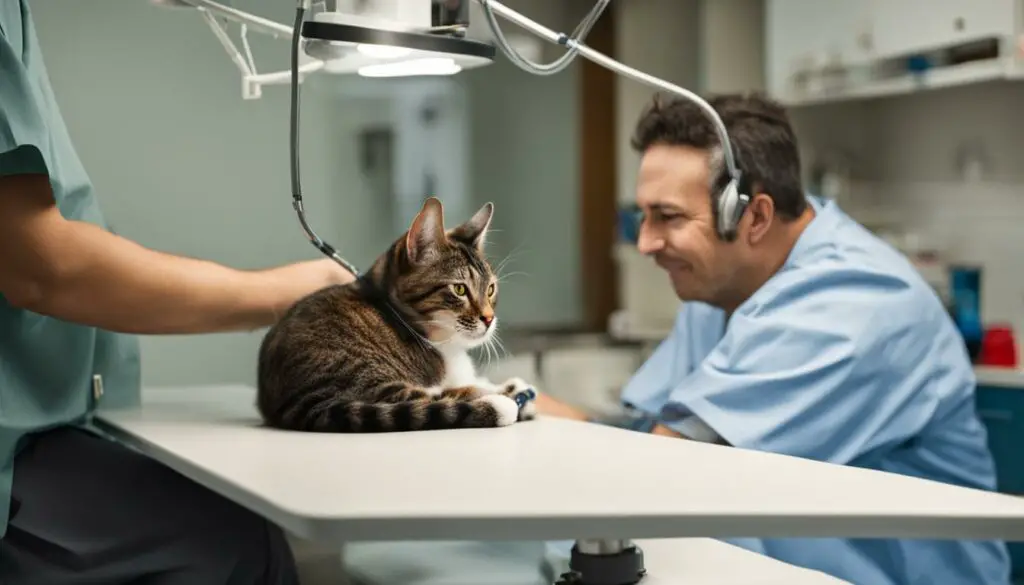
The Social and Territorial Nature of Cats
Cats are known for their social and territorial nature, which can play a significant role in urinary incontinence. Understanding these behaviors is crucial for cat owners, as they can help identify stressors and implement appropriate strategies to manage and prevent urinary issues.
Stress and anxiety are common triggers for urinary incontinence in cats. Changes in the environment, such as moving to a new home or the introduction of a new pet, can disrupt their sense of territory and cause increased marking behavior. This can lead to involuntary urine leakage and accidents in the house. By providing a stable and stress-free environment, cat owners can help alleviate anxiety and reduce the incidence of urinary incontinence.
Scent marking is another territorial behavior that can contribute to urinary issues. Cats have scent glands located in various parts of their bodies, including the paws, chin, and cheeks. They use these scent markings to establish their territory and communicate with other cats. However, during periods of stress or anxiety, cats may engage in excessive marking, including urine marking. This behavior can further exacerbate urinary incontinence.
Creating an enriched environment for cats can help reduce stress and anxiety associated with territorial behaviors. Providing vertical spaces, such as cat trees or shelves, allows cats to claim their territory and escape potential conflicts. Offering hiding spots and interactive toys can also provide mental stimulation and help alleviate stress. Additionally, pheromone diffusers or sprays can be used to create a calming atmosphere in the home.
| Key Points | Benefits |
|---|---|
| Understanding the social and territorial nature of cats | Helps identify triggers for urinary incontinence |
| Managing stress and anxiety | Reduces the incidence of involuntary urine leakage |
| Preventing excessive marking behaviors | Minimizes the exacerbation of urinary incontinence |
| Creating an enriched environment | Reduces stress and anxiety in cats |
By understanding the social and territorial nature of cats and implementing appropriate measures, cat owners can effectively manage and prevent urinary incontinence in their feline companions. Providing a stress-free environment, addressing anxiety triggers, and creating an enriched living space can significantly improve the overall well-being of cats and reduce the occurrence of urinary issues.
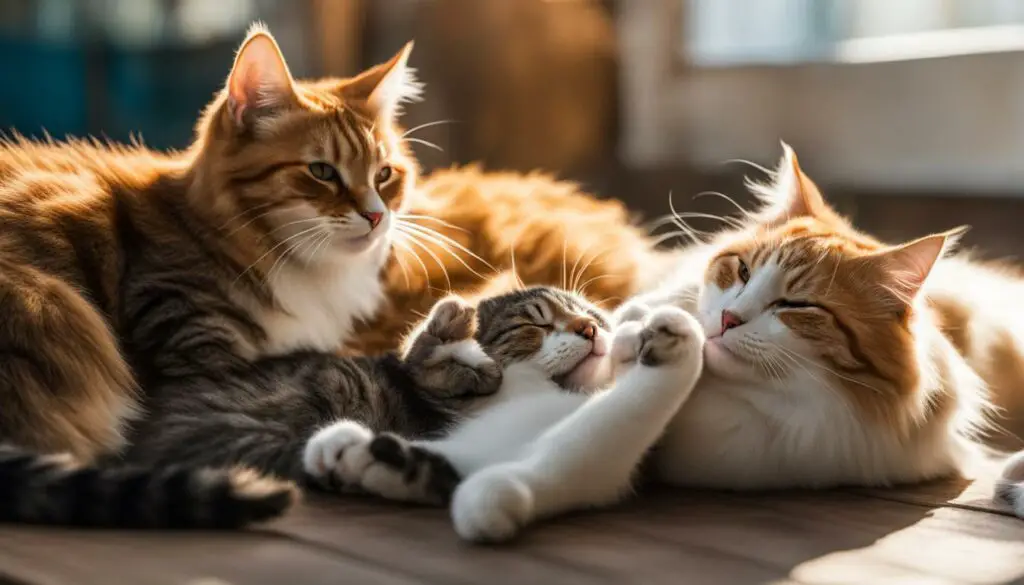
Conclusion
Cat peeing on himself can be a distressing issue, but with the right understanding, solutions, and preventive measures, it can be effectively managed. Urinary incontinence in cats can have various causes, including congenital factors, acquired conditions, and mimics of urinary incontinence. It’s crucial to work closely with a veterinarian to accurately diagnose the underlying cause and determine the best course of action.
Treatment options for urinary incontinence may include medications, supportive care, and in some cases, surgical repair. The veterinarian will tailor the treatment plan based on the individual cat’s condition. Additionally, creating a clean and stress-free environment, along with positive reinforcement training techniques, can help manage the symptoms of urinary incontinence.
Prevention plays a vital role in reducing the risk of urinary incontinence. Maintaining proper weight management, feeding high-quality food, and ensuring litter box hygiene are essential preventive measures. Regular veterinary check-ups are also important for monitoring the cat’s overall health and detecting any changes in urinary habits.
Remember, when dealing with urinary incontinence in cats, patience, consistency, and a holistic approach are key. By working together with your veterinarian and providing the necessary care and support, your feline companion can live a comfortable and healthy life.
FAQ
What are the symptoms of urinary incontinence in cats?
Symptoms of urinary incontinence in cats include not squatting or being in the position to urinate, the cat being unaware of urination, urine found in bed or near the urethral opening, and staining or smell near the urethral opening.
What are the causes of urinary incontinence in cats?
Urinary incontinence in cats can be caused by congenital or acquired factors, such as ectopic ureter or urethral sphincter abnormalities, spinal or vertebral abnormalities, and feline leukemia virus.
What can mimic the symptoms of urinary incontinence in cats?
Metabolic diseases such as diabetes, liver disease, hyperthyroidism, and renal disease can mimic the symptoms of urinary incontinence in cats.
How do veterinarians diagnose urinary incontinence in cats?
Veterinarians diagnose urinary incontinence in cats through a combination of physical exams and diagnostic tests, including assessing the size and thickness of the bladder, urinalysis, blood tests, and imaging tests such as radiographs or ultrasound.
How is urinary incontinence in cats treated?
The treatment for urinary incontinence in cats depends on the underlying cause and may involve medications, supportive care, symptomatic treatment, or surgical repair.
How long does it take for cats with urinary incontinence to recover?
Recovery time for urinary incontinence in cats varies depending on the cause and treatment. Close monitoring of symptoms and following the veterinarian’s orders are crucial for quick recovery.
How can urinary incontinence in cats be managed in the long term?
In some cases, urinary incontinence may not be fully resolved and can only be managed. This may involve dietary changes, acupuncture, hyperbaric chambers, litter box accessibility, and the use of pheromones or vitamin supplements to decrease stress.
Can urinary incontinence in cats be prevented?
While not all causes of urinary incontinence in cats can be prevented, certain predisposing conditions can be avoided. Weight management, feeding good-quality food, and maintaining proper litter box hygiene can help minimize the risk of urinary incontinence.
Can anxiety and stress cause urinary incontinence in cats?
Yes, anxiety and stress can potentially cause urinary incontinence in cats by affecting bladder and urinary tract function. Providing a supportive and calming environment can help alleviate their symptoms.
How can positive reinforcement training help with urinary incontinence in cats?
Positive reinforcement training techniques can be valuable in addressing urinary incontinence in cats by promoting good litter box habits and encouraging the use of the appropriate area for urination.
How should the litter box be set up and managed for cats with urinary incontinence?
The litter box should be in a quiet and accessible location, kept clean, and provided in an appropriate size that suits the cat’s preferences. Monitoring the cat’s litter box habits and making adjustments as needed can help facilitate better urinary control.
How important is cleanliness and odor control in managing urinary incontinence in cats?
Maintaining cleanliness and managing odors associated with urinary incontinence is essential for the cat’s comfort and hygiene. Regular cleaning of the litter box and affected areas outside the litter box can help minimize odors and prevent infections or irritations.
How important is litter box training and reinforcement for cats with urinary incontinence?
Litter box training and reinforcement are vital for cats with urinary incontinence. Consistent and positive training methods can help the cat understand that the litter box is the appropriate place for urination and encourage proper litter box habits.
How often should cats with urinary incontinence have regular veterinary check-ups?
Regular veterinary check-ups play a crucial role in managing urinary incontinence in cats. Through routine examinations, veterinarians can monitor the cat’s overall health and detect any underlying conditions or changes in urinary function.
What should be considered regarding the social and territorial nature of cats in relation to urinary incontinence?
The social and territorial nature of cats can influence urinary incontinence. Understanding these behaviors and providing appropriate environmental enrichment can help reduce stress and minimize the occurrence of urinary incontinence.
Source Links
- https://www.purina.co.uk/articles/cats/health/special-needs/incontinence-in-cats
- https://wagwalking.com/cat/condition/lack-of-bladder-control
- https://petmd.com/cat/conditions/urinary/c_ct_incontinence_urinary

